Contents
A flower garden without terry dahlias will not look so rich. These flowers adorn gardens and flower beds from mid-summer until the first frost. Thanks to the diligence of breeders, every dahlia lover has the opportunity to plant a variety of varieties of these flowers on his site.
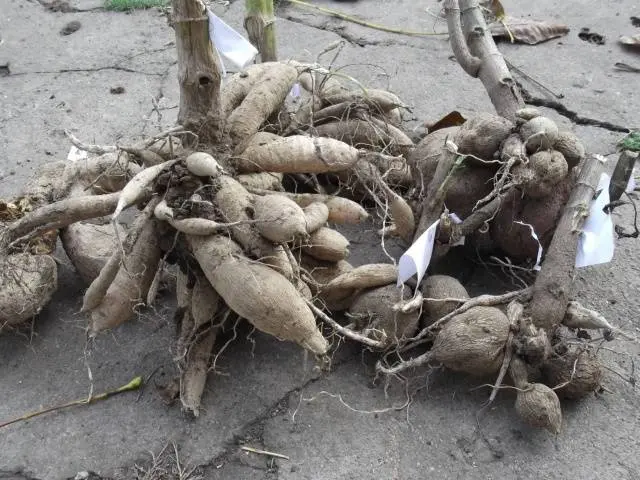
However, in order for these flowering plants to delight you year after year, it is important to know how to keep dahlias at home. This is exactly what will be discussed in this article.
When and how to dig up dahlia tubers
In order for your favorite flowers to survive the winter cold and bloom magnificently next season, it is important to dig them up correctly and in a timely manner. Digging up the roots should be carried out with the onset of the first frost. During this period, the leaves of the ground part of the flowers acquire a characteristic black color.
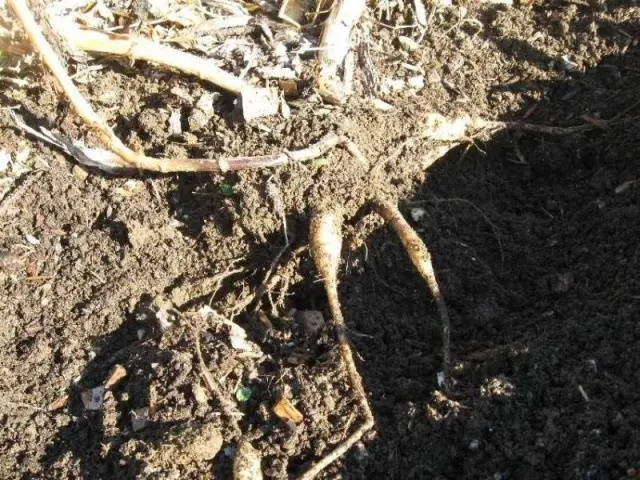
Before the specified time, it is not worth digging up the roots, otherwise the flowers in the next season will bloom less intensively, and the tubers will be more susceptible to disease and decay. If the leaves on the plant are green, then it is too early to dig up the roots, since at this time the buds are preparing for re-flowering, and the process of feeding the root system is in the active phase.
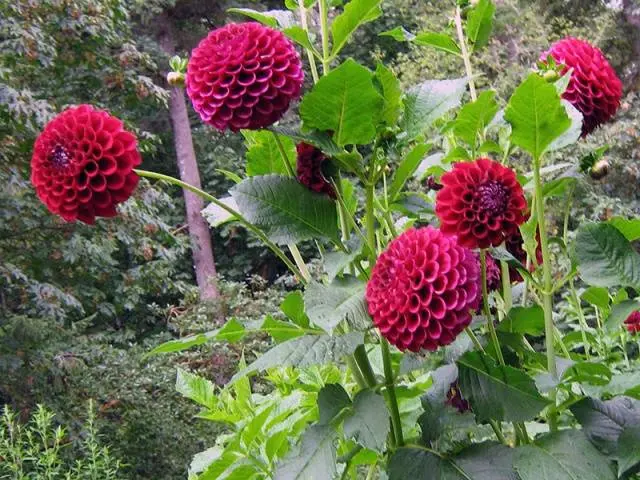
If the digging period has already come, then it is necessary to trim the stems. So, you can avoid involuntary damage to the kidneys and tubers. When digging, do not put a shovel close to the stems and do not pull the plant with your hands by the stem.
To safely dig out the roots, dig the plant from all sides at a distance of 30 cm from the stem. Then rake the soil with your hands and carefully remove the root system. Another key to the successful storage of dahlia tubers is the thorough preparation of planting material for wintering.
Preparation for wintering
If you have already dug up the tubers, then they need to be prepared for the winter. To begin with, they are washed in running water and disinfected. A weak solution of potassium permanganate or a fungicide can be used as a disinfectant. The roots are placed in it for half an hour.
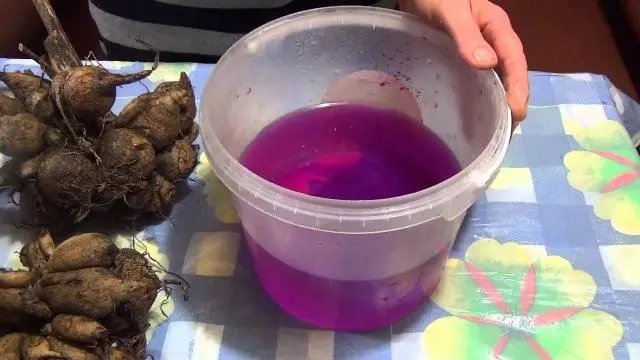
Some gardeners add a systemic insecticide to the disinfectant solution. This approach will save the maximum amount of planting material until spring. If enough time is given to disinfection, then the likelihood of the spread of pathogenic bacteria and, as a result, the decay of dahlia roots will be minimal.
In order to avoid damage to the skin of the hands, it is better to work with chemicals with gloves. Tubers that float are not suitable for storage and must be collected and discarded.
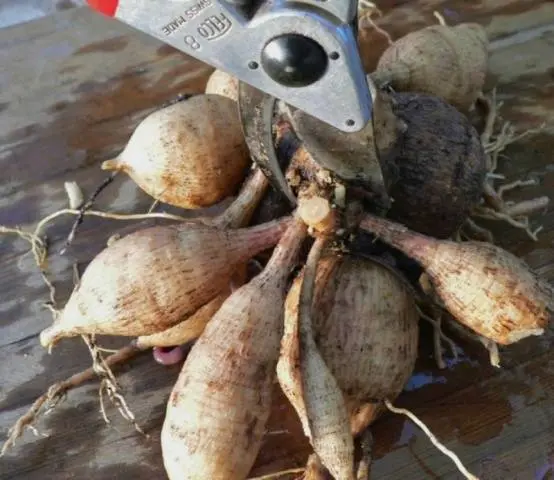
After that, the tubers should be dried. It is best to do this in the sun or in a dry, bright and well-ventilated area. Then the tubers are divided into divisions. It is best to dry the roots on a wooden surface covered with cardboard or paper.
Why and how to mark the roots
If you grow different varieties of dahlias, then in order not to get confused in them, you should label the tubers. You can write the names of the varieties in full or make a plate with codes on a separate sheet of paper, and simply number the tubers themselves. Mark with some special icon, for example, an asterisk, a plus sign or a tick, the strongest tubers from the same variety. So, with the advent of spring, you can use the best planting material.

The numbering of the roots can be done with an indelible pencil, which writes well even on completely dry tubers. If the pencil does not write well, then moisten its tip in a jar of water. A pencil can be replaced with a marker that writes well on any surface.
Storing dahlias at room temperature
There are a number of rules to help keep dahlia tubers even at room temperatures:
- Place the roots in perforated plastic bags pre-filled with dry brown peat moss. Packages should be tightly tied. You can store planting material in a closet, pantry or on the threshold of a loggia. In this case, you need to regularly check the general condition of the tubers.
- You can dust the tubers with ashes and then place them in plastic bags. Fill the bags with air and tie them, and then carry them to the place of permanent storage.
- If you have a little planting material, then you can store it in the refrigerator. You need to put each tuber in a separate bag.
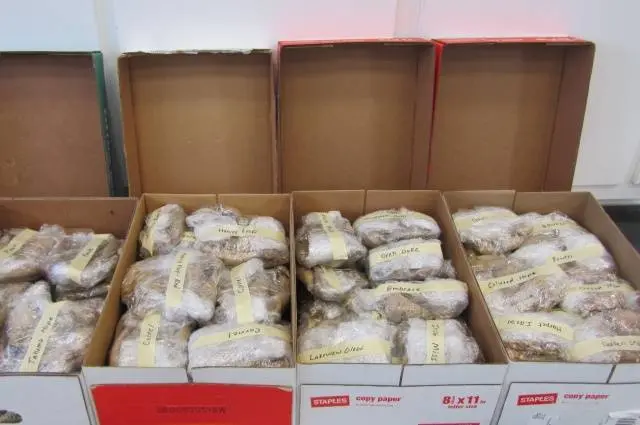
If your house has an unheated room, then it is best to store the tubers in it. At high temperatures, roots can germinate and die from a lack / excess of moisture, soil and nutrients.
Storage methods at home
Storage of dahlias at home can be done in different ways. For example, in boxes with sand or sawdust. Some flower growers process planting material with paraffin or vermiculite. We suggest that you familiarize yourself with each method of storing dahlias in the winter.
In the boxes
The best place to store dahlias at home is in drawers. At the bottom of the box, you can put a layer of peat, then lay the roots on it and cover them again with peat. An excellent substitute for peat can be sand or sawdust, but this will be discussed later.
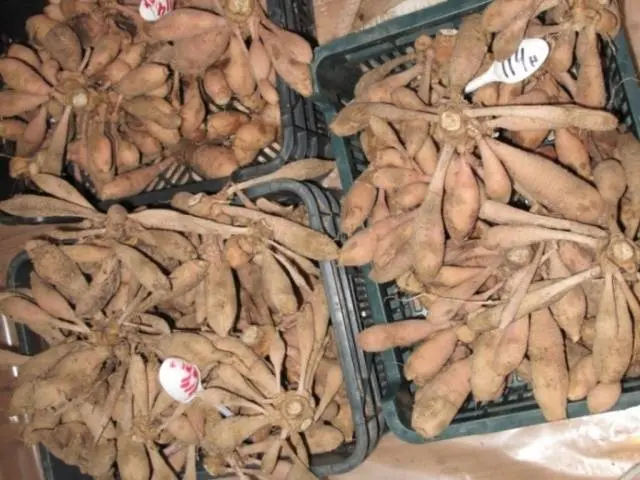
Under such conditions, dahlia tubers will remain until spring. After that, you can land them in open ground.
In sand
If you decide to use not peat, but sand as a backfill for the box, then you must take into account that the latter must be well dried. A layer of sand is poured at the bottom of the box. After that, tubers are laid on it in 1 or 2 layers and covered with burlap. The technique received good reviews. It is convenient that at any time you can easily check the condition of the tubers.
If it seems to you that the roots are drying out due to dry sand, then do not rush to conclusions. Excess moisture is not needed for tubers sent for winter storage, as it can cause them to rot or sprout prematurely. Therefore, it is better to let the roots dry out than to let them rot.
in sawdust
In order for the tubers to be well preserved, they need to be covered with large sawdust or even wood shavings. The fact is that small sawdust strongly absorbs moisture, which can lead to decay or germination of planting material.

Do not store dahlia roots with potatoes or other vegetable crops. A humid environment is formed near vegetables, and this can provoke the spread of fungi, which will lead to the death of planting material.
Paraffinization of dahlia tubers
Skillful gardeners resort to waxing dahlia tubers. The bottom line is that the prepared planting material is dipped into molten paraffin. This method allows you to keep the roots of dahlias in the most natural form until spring. So, enough moisture remains in the roots and they do not dry out. Under the influence of high temperatures, pathogenic bacteria die, which can remain on the tubers after disinfection. The paraffin layer protects the tubers from the negative influence of the external environment.

Waxing is suitable for processing early varieties of dahlias. How to save dahlias in winter by waxing? You need to do the following:
- Grind candles or paraffin wax and place in a saucepan. Make a water bath.
- Melt the paraffin over low heat. The thickness of the melted paraffin should be approximately 2-3 cm.
- In order for the roots to fit in the pan, they need to be separated. Tie the pre-washed and dried tubers by a thread, dip in paraffin for 1 second and remove. Under the influence of oxygen, paraffin will harden instantly.
The use of vermiculite
Another way to store dahlias in the winter at home is to use coarse vermiculite as a backfill for boxes. This tool retains moisture well, so you should not be afraid of drying out the roots.
The bottom of the box or other container in which the planting material will be stored is covered with vermiculite. Then dahlia tubers are laid on this layer. The roots are again sprinkled with vermiculite and so you can shift several layers in the box. The last layer should be covered with polyethylene. The tubers should be kept in a temperature range of 3-6℃.
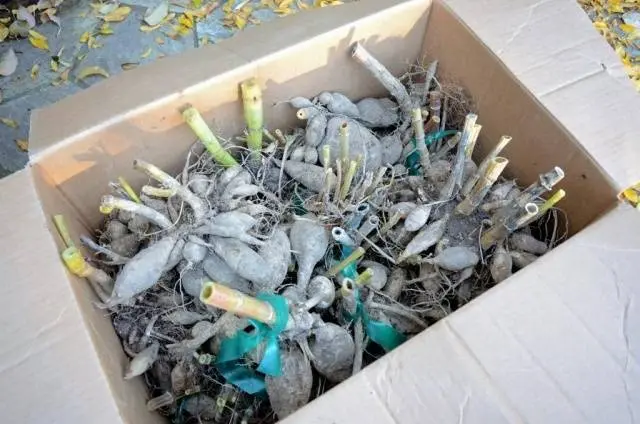
Conclusion
So, from this article, you learned how to store dahlia tubers in winter. If you follow the above recommendations, then next season you will be pleased with beautiful flower beds, covered with the lush color of delicious dahlias. In addition, you can watch a video that talks about the secrets of storing dahlia tubers:









